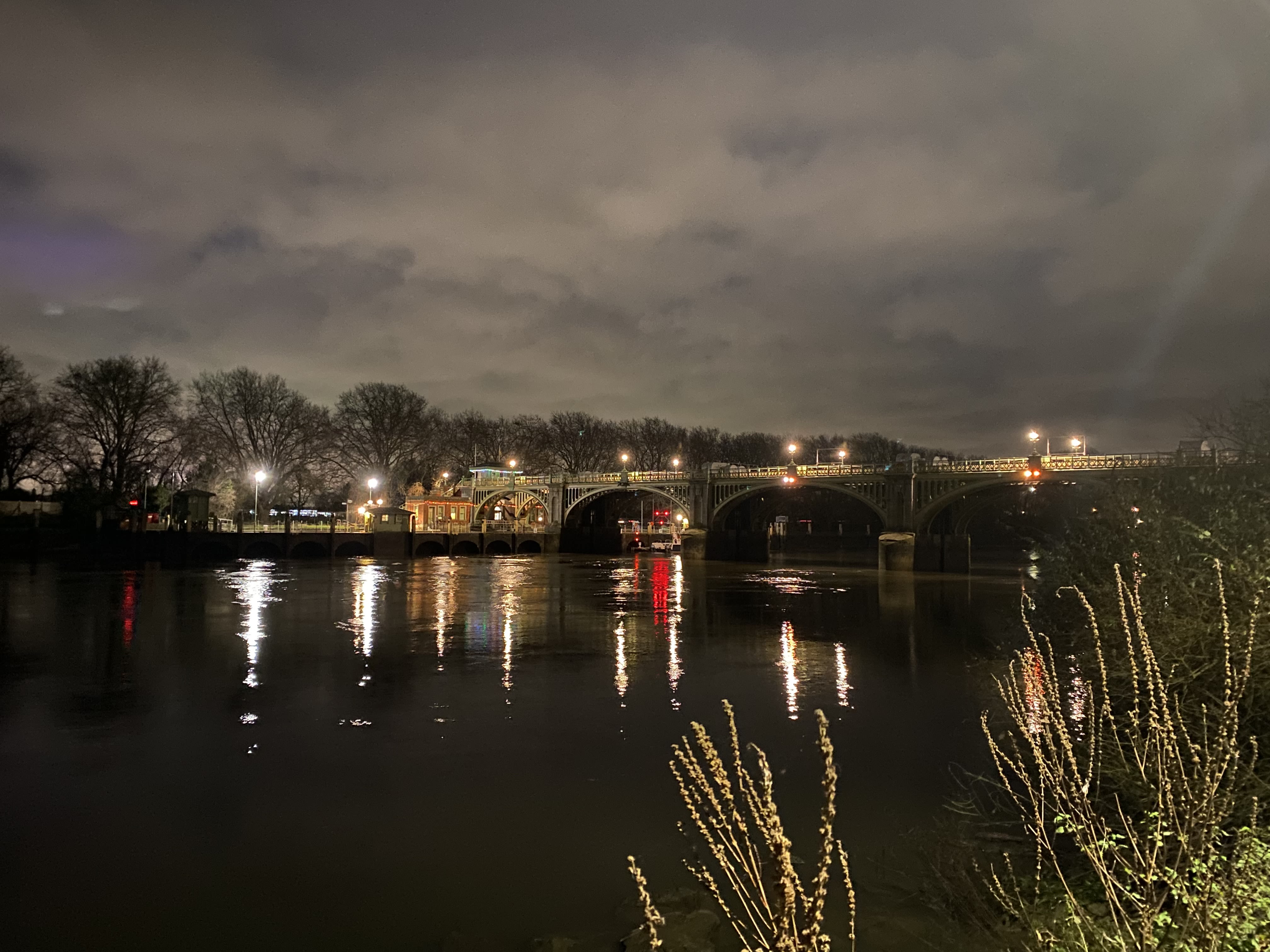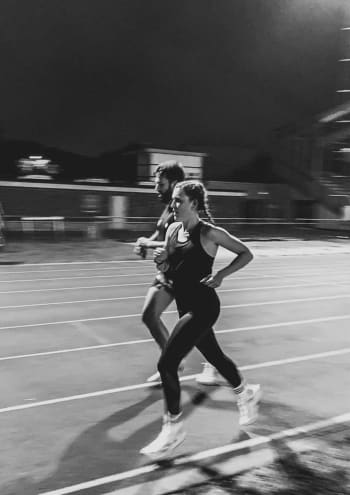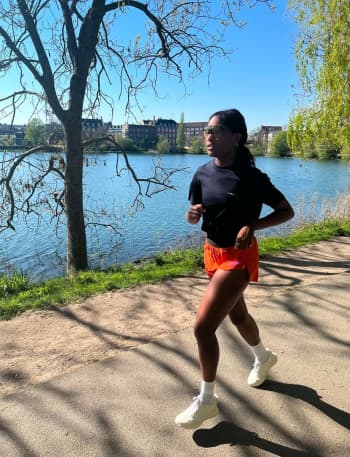Are London's waterways safe for women runners?
Rebecca Whalley
"It's not violence against women and girls - it's male violence."
Sarah Ackland, Runner
Women in the UK are 160% more likely to cite a lack of safe places to exercise as a barrier, compared to 9% of women globally, a Strava study revealed.
Despite that, increasingly more women are taking up running with 28,000 taking part in the TCS London Marathon this year, a considerable portion of which is along the Thames.
But outside of the marathon, these waterways are hotspots for harassment towards runners, from catcalling to sexual assault.
A 2023 study by Adidas showed over a third of women had experienced verbal or physical harassment, and 50% had been followed while running.
Thousands of women in London have joined women-only running clubs to feel safer while exercising.
Occupying space as a female runner
Sarah Ackland, 31, leads Your Friendly Runners in Hackney once a week.
Established in 2018, the inclusive run club now attracts over 100 runners every week.
Ackland has been running in London for eight years, and said she has faced harassment countless times.
TRANSCRIPTION: I can't even remember how many times I've been publically harrassed. But I actively avoid the canals after dark, or even dusk.
Ackland has recently completed a PhD at Newcastle University, with a project titled 'Taking Space', consisting of a series of runs to address inequality for women in the UK.
She uses what she calls "joyful movement" to collectively challenge perceptions and how women are made to feel in spaces that women traditionally fear.
She said she spends a lot of time running safer routes, and ones which she knows have exit points.
Ackland also prefers running in places with passive surveillance, whether it be coffee shops or playgrounds.
But she is frustrated that seeking passive surveillance is something women have to even consider.
She thinks messaging by the media is damaging, as it fails to pin responsibility on men responsible for violence against women.
TRANSCRIPTION: "I think it is a really sad reality that in 2024 we can't enjoy public spaces with inequity with men, because of men. I think the media has a lot to answer for a lot of the messaging around it - it's not violence against women and girls - it's male violence."
Almost three-quarters of women in the UK change their outdoor routines during winter, according to This Girl Can.
Local gyms provide an alternative, but they can be incredibly expensive.

'Catty Calls': testimonies from female runners
Ackland created a forum for women runners, called 'Catty Calls', to which women submit details of their experiences of harassment. Although her findings are not yet published, she shared two accounts with me.
These are two accounts of harassment by women runners in Hackney.
Image credit: N Chadwick via Wikimedia Commons
Image credit: N Chadwick via Wikimedia Commons
Regent's Canal
"I was running down the Regent's Canal on the way to Victoria Park, towards the second gate leading in the park.
Just before you come to the second gate of the park you go under a bridge and the path gets pretty narrow. Just before that bridge two guys were walking towards me, I think they were playing music from a speaker.
As I was going past them one of them stopped, turned around towards me staring at me and shouted ‘Smile Darling’."
- January 2024
Image credit: Malc McDonald via Wikimedia Commons
Image credit: Malc McDonald via Wikimedia Commons
Victoria Park
"Cat called not once... not twice... but FIVE times!
Met my friend for a lunch-time run (at Knees Up) and single lap around Victoria Park. As soon as we set off we were cat called by a man in a white transit van.
We proceeded to be honked and shouted at by four other men in the space of a 45 minute run along Hackney Road, Regent's Canal and Victoria Park.
To top things off, my friend was later cat called by a man with his kid in the car."
- August 2024
How does safety vary by area?
Laura Blythe, a 24-year-old public law case worker, spoke to me about her experiences running along the Thames around Chelsea and Putney, having moved from Oxford three months ago.
She said she feels safe running around this part of west London, but avoids more dangerous areas and London's canals.
A video of Laura Blythe, a public law case worker and regular runner, talks about her experiences running along the Thames in west London.
A video of Laura Blythe, a public law case worker and regular runner, talks about her experiences running along the Thames in west London.
Sexual offences are on the rise
From 2019 to 2024, there were 87 reported cases of sexual offences along London's waterways against women, and 10 against men, data from a Freedom of Information request to the Met Police shows.
Waterways includes routes alongside the Thames, resevoirs, canals and other rivers.
Women were the victims of 89% of sexual offences along London's waterways over the past six years.
Comparitively, men experienced 83% of robbery offences along waterways, with 258 reported male victims, and 53 female victims over the six years.
However, there are likely many more cases of sexual offences along waterways, as many women say they feel uncomfortable dealing with the police.
Only 25% of women reported harassment in fitness and leisure centres to the police, according to This Girl Can and UK Active
However, in 2022, around 7.9 million over 16-year-olds experienced sexual assault and 1.9 million were victims of rape, according to the Crime Survey of England and Wales.
It was estimated 7.7% women and 0.2% men in the UK were victims of rape.
Reports of sexual offences have been steadily increasing since 2012, the Crime Survey suggests.
Intersectionality in safety while running
Feyisola Latunji is an experienced marathon runner from Hackney, who has expressed frustration at the lack of safe running routes for women in the capital.
She said: "Awful things happen and women are attacked.
"Something will happen in the news, and everyone gets super aware of it, and then everyone forgets again, and then someone gets attacked."
If Feyisola ends up on a canal alone, she said she makes sure she's running along a section with plenty of exit points, like Ackland.
TRANSCRIPT: "Like I guess there's bits of canal where you're running kind of straight and you can see whatever's coming in front of you. But then there are bits when you're running around a bend and you're under a bridge and it's not even for very long but it's dark. Each time you go round it you just can't see who's coming towards you in that moment. And I think that for me is the bit I really don't like. So often I think 'what if there's someone hiding there?"
Feyisola said she has to run in the dark to train for her marathons during the week as she goes to work and comes home in the dark, but gets frustrated by suggestions that she should stay in after dark.
TRANSCRIPT: "My dad will be like, ‘you know you shouldn't run in the dark’. And I'm like, ‘what, so I just don't exercise?’ Why does that have to be my reality? Maybe we just don't get to run in the dark. I just find that a really frustating idea."
"I think if we're going to tackle this problem the answer to it can't just be an alternative - the gym isn't an option for everybody anyway, because gyms aren't free.”
Citing that 51% of the UK’s population are women, Feyisola said the issue of women’s safety affects over half the population, and so more awareness is needed.
She suggested men need to be aware of the reality women face when out for a run, and they need to listen to women when they say they feel unsafe.
As a black female runner, Feyisola said she thinks intersectionality plays a big part in the safety of female runners.
She said: "I do feel like it's very easy to live in like a bit of an echo chamber. And think that you might feel like you live in an area that's safe for women, but is it safe for all women?"
She cited that October is Mental Health Awareness Month, and there is a narrative promoting the importance of regular exercise.
She said: "Half the population don't get to do that.
"So how is that a viable mental health release?"

How can we improve women's safety while running?
Do you think London feels a safer place to run than it did five years ago?
This Girl Can is a campaign that aims to tackle the gender activity gap. Launched in 2015, it works to change how women think and feel about exercise, encouraging them to take up space indoors and outdoors.
Kate Dale, director of marketing at This Girl Can and Sport England, said: "It’s not about whether it feels more or less safe than before.
"It should feel safe, it doesn’t, and that’s not good enough. We all have the right – and the need – to get active in the ways that work for us, when we want, how we want. It breaks my heart that over 70% of us women change the way we get active outdoors once the clocks go back."
What more do you think could be done at the community level to prevent women from being catcalled or harassed while out running?
"Communities must rally around women’s safety.
"Start with better lighting and public areas designed with women in mind - because a well-lit path isn’t just safer, it sends a message that women belong there. Education is crucial too: teaching respect and allyship to dismantle toxic behaviours like catcalling.
"Reporting frameworks should make it easy for women to report harassment, with real consequences for offenders. Change starts in our neighbourhoods, but it needs every voice to join in.
"And we can all play our part. Calling out mates who may think it’s funny to catcall, asking a woman on the receiving end of it if she’s ok, asking the women in your life to talk about their experiences – that will all make a difference.
"We shouldn’t have to and it’s time we all stopped accepting it as inevitable, just one of those things. Talking about it, raising awareness of the injustice of it is the first step towards bringing long-term change."

Why do you think women do not feel comfortable going to the police?
"Our Safer Spaces to Move research highlights the broader challenges women face when considering whether to report incidents of sexual harassment and intimidation. For example, 42% of women in our survey reported experiencing at least one form of sexual harassment and intimidation in their fitness and leisure centres, rising to over four in five (83%) among women aged 16-24. However, of the 42% of women who have experienced sexual harassment and intimidation in their fitness and leisure centres, only 25% of those reported it."
What are the Met doing to tackle violence against women?
The Met police launched an action plan in December 2023 outlining their response to Violence Against Women and Girls (VAWG), which includes ten commitments.
These include tackling sexism and misogyny in the Met, improving how they listen and identifying high risk locations.
In a foreword to the plan, Deputy Assistant Commissioner Helen Millichap KPM said in 2022 that the Met acknowledges that VAWG is a high harm and high volume threat to the public and its scale is underestimated.
She said: "We support the work national policing is doing to illustrate the scale of the threat. We have an urgent need for collective action and a whole system response, which goes well beyond the policing sphere."
In a 2024 update, the Met said they have increased the number of rape and domestic abuse positive outcomes. A positive outcome includes charges, cautions or penalty notices.
They also said they secured 6,002 new positive outcomes for VAWG cases overall.
Nonetheless, sexual offences in London reached their highest level in four years in August 2024.
It's clear that more work needs to be done by police and communities to tackle violence against women, whether it's inside the home or while running outdoors.
New Scotland Yard, Met Police Headquarters. Image credit: Colin McLaughlin via Wikimedia Commons.
New Scotland Yard, Met Police Headquarters. Image credit: Colin McLaughlin via Wikimedia Commons.







